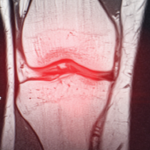Imaging

Andrew Filer, PhD
The final speaker in the session, Andrew Filer, FRCP, PhD, professor of translational and experimental rheumatology, University of Birmingham, U.K., spoke on the subject of imaging of RA synovium in order to better understand the cellular architecture of synovitis. Referring back to the concept of CTAPs, Dr. Filer pointed out that, using low dimension stains from synovial tissue, two things can be shown: 1) what is happening in the CTAPs in terms of cell types can be replicated with histology and 2) consistent findings can be seen in the same joint when comparing disaggregated synovial tissue and four to six tissue samples that have been biopsied and stained.
The main thrust of the work from Dr. Filer and colleagues has to do with the concept of obtaining synovial tissue biopsies and projecting cell clusters onto the tissue space. In doing so, it has been possible to demonstrate that there is diversity within the RA synovium (and that this diversity has spatial and regional correlates) and that T and B cell CTAPs and the myeloid cell CTAPs differ in their macrophage/lymphocyte niches. These findings may have important implications for treatment targets for patients who fall into different CTAP groups.
In Sum
The session was notably innovative and represents the cutting edge when it comes to better understanding and, ultimately, treating conditions like RA using advanced technologies for investigation. With such a granular understanding disease, rheumatologists may one day be able to tell patients how their condition can be impacted even at most microscopic level.
 Jason Liebowitz, MD, is an assistant professor of medicine in the Division of Rheumatology at Columbia University Vagelos College of Physicians and Surgeons, New York.
Jason Liebowitz, MD, is an assistant professor of medicine in the Division of Rheumatology at Columbia University Vagelos College of Physicians and Surgeons, New York.
References
- Zhang F, Jonsson AH, Nathan A, et al. Deconstruction of rheumatoid arthritis synovium defines inflammatory subtypes. Nature. 2023;623(7987):616–624.
- Dunlap G, Wagner A, Meednu N, et al; Accelerating Medicines Partnership Program: Rheumatoid Arthritis and Systemic Lupus Erythematosus (AMP RA/SLE) Network, et al. Clonal associations of lymphocyte subsets and functional states revealed by single cell antigen receptor profiling of T and B cells in rheumatoid arthritis synovium. bioRxiv [Preprint]. 2023 Mar 21:2023.03.18.533282.
- Kozlowska J, Humphryes-Kirilov N, Pavlovets A, et al. New genetic insights in rheumatoid arthritis using taxonomy3, a novel method for analysing human genetic data. medRxiv [Preprint]. 2023 Feb 21:2023.02.21.23286176.
- Weinand K, Sakaue S, Nathan A, et al; Accelerating Medicines Partnership Program: Rheumatoid Arthritis and Systemic Lupus Erythematosus (AMP RA/SLE) Network; et al. The chromatin landscape of pathogenic transcriptional cell states in rheumatoid arthritis. bioRxiv [Preprint]. 2023 Apr 8:2023.04.07.536026.
